
Yes. That is correct. Eight planets. Not nine, since Pluto was decommissioned and reduced to a planet dwarf planet in 2006 that is part of the Kuiper Belt. An area at the edge of the solar system that is filled with icy bodies that orbit the sun.
A dwarf planet is an object that revolves around the sun but is not considered a planet because it doesn’t meet the criteria set forth by the International Astronomical Union (IAU), an international organization that helps to set the standard for outer space quantifications.
Want to learn more about the dwarf planet, Pluto, check it out here.
The Eight Planets
Mercury
The planet Mercury is mainly composed of the element iron. It is one of the few planets that have no moons and there is a good reason. Being so close to the Sun, the gravitational pull would grab those moons like a magnet, and they consequently would be incinerated.
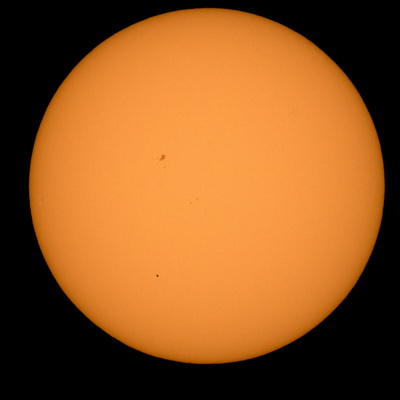
Designated as the smallest planet in our solar system, Mercury is the closest planet to the sun. Only 36 million miles or 0.39 AU (astronomical unit. The distance from Earth to the sun has an AU of 1).
It orbits the sun every 88 Earth days. (The closer the planet is to the Sun, the faster it revolves around it) and it passes between Earth and the sun only about 13 times a century. The last pass was in 2006.
Mercury has a thin atmosphere. We humans as well as all air-breathing mammals on this planet would not survive in Mercury’s atmosphere without protective equipment, but it is unlikely you would want to go there anyway when the average temperature is 354 degrees F. In 1974, two spacecraft visited Mercury: Mariner 10 and Messenger. Learn More about Mariner.
Venus
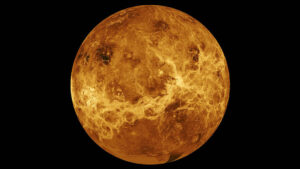
The second planet from the sun and slightly smaller than Earth, it revolves around the sun every 225 Earth days. Over 40 spacecraft have explored Venus. Notably, Magellan mapped over 98% of the planet’s surface. Venus’ temperatures can go up to 480 degrees. The planet is unusual as it spins backward, resulting in the sun rising in the west and setting in the east.
Earth
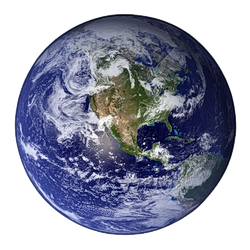
Where would we be without it? Our planet is located in the Goldilocks Zone. The name was coined from the Three Bears children’s story. We are situated in the area of the solar system where it is not too hot, not too cold, but just right for life as we know it to exist and strive.
With that said, scientists are currently looking at exoplanets (planets outside of our solar system) that also are in the Goldilocks Zone. 15% of all stars in our galaxy have planets orbiting around them and if you add them together, it would total over 500 habitable planets that have been discovered so far, so who knows? We may not be alone after all!
Getting back to Earth’s facts, we are the third planet from the sun and 93 million miles away, or one AU from the sun.
Mars
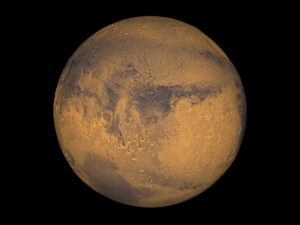
No doubt the passion of classic sci-fi writers in the middle twentieth century, including the famous War of the Worlds broadcast by Orson Wells, Mars has driven the curiosity of life, if not now, then within this millennium. Some scientists do believe that Mars once sustained life many years ago and MASA is searching the planet with the Mars Voyager program to determine just that. If confirmed, scientists can determine that Earth is not the only planet that can sustain life, which would be probably the biggest scientific breakthrough in history!

The planet is conveniently located between the Earth and Jupiter as the fourth planet from the sun at a distance of 142 million miles or 1.52 AU when it is furthest from Earth. About 39 million miles at its closest. Mars makes a complete orbit around the sun every 687 Earth days.
The two moons orbiting Mars are Phobos and Deimos.
There are plans by NASA to send men or possibly women as well to Mars. But we better hurry up as China is also planning on manned missions to Mars as well.
Jupiter
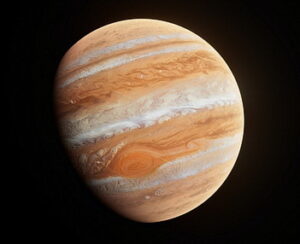
Besides being the largest of the eight planets, what also makes Jupiter popular is its giant red dot, which is large enough to encompass the planet Earth. It is a gigantic storm of immense proportions that has been happening since we first discovered Jupiter hundreds of years ago. This planet is so large that if it was a soccer ball, Earth would be a pea in comparison.
Jupiter is about 484 million miles, 5.2 AU from the sun.
Jupiter makes a complete orbit around the sun every 12 Earth years. Known as the ‘gas-giant’, it has no solid surface. Imagine landing on Jupiter with no solid surface!
53 moons are revolving53 moons revolving around this body.
Saturn

Saturn is the sixth planet from the sun (886 million miles, 9.5 AU from Earth.) Saturn makes a complete orbit around the sun every 29 Earth years. As with Jupiter, Saturn is also a gas giant with no solid surface. 82 moons are orbiting Saturn. Fifty-three of these moons have been calculated by scientists and another 29 have been located but are awaiting confirmation.
Some of Saturn’s moons are larger than the planet Mercury like the moon Titan and some are smaller than a football stadium. Saturn is probably the most popular plant with its outer rings circling it. The rings, seven in all are gaseous objects that stay intact due to the planet’s gravitational pull.
Uranus
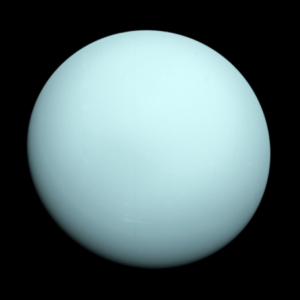
Not nearly as much fun to look at as Saturn, the planet Uranus orbits our sun at a distance of about 1.8 billion miles or 19.19 AU.
It takes Uranus to make a complete orbit around the sun in about 84 Earth years. Because of the distance from the sun, Uranus is a cold, icy planet. The planet contains 27 moons revolving around it.
Neptune
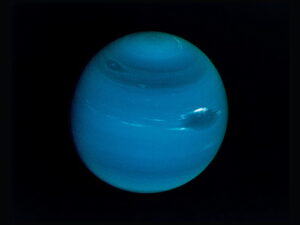
Update 9/23/22
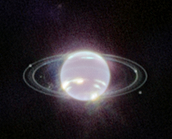
On September 21, 2022, the James Webb telescope took the clearest images of Neptune’s rings so far. These images were taken with Webb’s infrared camera, so their color does not display. Instead, we see a glassy-looking mostly due to the methane gas that is so abundant. This gas is so strong that it absorbs the infrared light resulting in the planet looking rather dark, but this darkness doesn’t show because of the high-altitude clouds that are present and that is what we see in the images and are shown as bright streaks and spots because it is reflecting the sunlight.
_______________________________________________________________________
Neptune is known as the god of the sea in Greek and Roman mythology. The planet was first discovered in 1846 and took on this name. It is 2.8 billion miles, 30.07 AU from the sun.
Like Uranus, Neptune is also a cold planet. Even colder than Uranus and is labeled as an ice giant, not a gas giant like Jupiter. Neptune has 13 moons and has rings, although not nearly as noticeable as Saturn’s rings.
It takes Neptune 165 Earth years to revolve around the sun. And just recently, it was discovered that the temperature of Neptune unexpectedly went down. Scientists are baffled as to why. Guess we’ll just have to go there to find out!
Conclusion
There you have it. The eight planets are in our solar system, but we are definitely not alone. At least in solar systems that are. Based on research, there could be over one billion solar systems in our Milky Way galaxy alone. Just think about what’s out there when we consider the trillions of galaxies in our universe!
